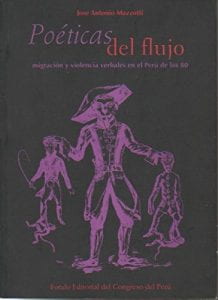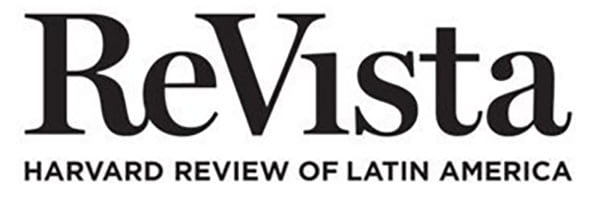A Review of Poéticas del flujo: Migración y violencia verbales en el Perú de los 80
Peruvian Poetry

Poéticas del flujo: Migración y violencia verbales en el Perú de los 80. By José Antonio Mazzotti Fondo Editorial del Congreso del Perú, Lima, 2002, 234 pages
José Antonio Mazzotti, in his second book, Poéticas del flujo. Migración y violencia verbales, identifies the different trends in 1980s Peruvian poetry. With characteristic flexibility and a wide-ranging scope, Mazzotti offers the reader a fresh critical analysis of this period of literature. He also gives us innovative ways of looking at literature, culture and the national imaginary in Perú. His analysis can be taken as a reference point for future reflection on Peruvian literary production.
Mazzotti, an associate professor of Spanish in Harvard University’s Department of Romance Languages and Literatures, recognizes the continuous intersections between art and society in which art fulfills the role of transcribing and portraying in movement what is happening within society. At times, Mazzotti points out, art can also set the agenda and ignite the spark that actually puts into motion societal change. Through literary interpretation, the author recognizes new spaces of political representation that emerged in the 1980s, particularly in the realm of poetry. Each chapter takes a close look at these new spaces.
The study opens with an examination of Quechua poetry developed during that period. This phenomenon is closely related to the mass migration from the countryside to Lima, the so-called “Andeanziation” of Perú’s capital city. The Quechua poets are migrants themselves, and Mazzotti gives eloquent testimony to their fractured—although not tragic—existence. He portrays them as divided in an unresolvable ambivalence between the secularization of the modern city and the traditional mythic thought of the Andean world.
The second chapter of Poéticas del flujo focuses on poetry by women. This type of poetry reflects the attempt to achieve a genuine position within the patriarchal society through the transgression of the limits imposed on feminine sexuality. Mazzotti demonstrates great astuteness in perceiving this phenomenon as a growing trend in which the voice of the rebellious woman—still sullied by “phalocentric” and “machista” canons—is demanding to be recognized in terms of absolute parity, that is, as an authentic political entity.
The third chapter takes a close look at Perú’s insertion into the world of market capitalism and mass culture. Listening to the words of urban poets with a fine stethoscope, Mazzotti demonstrates that the forms and schemes once considered foreign impositions or “alienating” have become an integral part of Peruvian culture without denigrating it. Indeed, these foreign influences have enriched the culture and have affirmed its many-sided nature. There is an implicit faith in the potential of Peruvian culture to readapt and take advantage of outside influences.
In contrast, the last chapter recognizes the trauma of modernity in Perú, as well as the conflictive road map created by hitherto unknown economic and social processes on a worldwide scale. The figures of the unemployed Peruvian, those trapped in the informal economy, and the drug addicts, emerge here painted in all their desolation, their fury, and their political nihilism. To them, Mazzotti dedicates his perceptive and critical gaze.
Fall 2003, Volume III, Number 1
Rafael Espinosa is a Peruvian poet and a member of the Working Group on Culture in the Peruvian Congress. A version of this book review was previously published in the press release notes accompanying the launching of the volume in Lima.
Related Articles
A Review of Bodies Found in Various Places
This bilingual anthology of Elvira Hernández, translated by Daniel Borzutzky and Alec Schumacher and published by Cardboard House Press, offers a comprehensive entry point into the work of the Chilean poet. The translators’ preface offers a valuable introduction that provides important context to her work and explains aspects of her poetry present in the volume, such as Hernández’s self-effacing “ethics of invisibility,” an ars poetica in which the poems stand in front while the poet hangs back, in a call to observe rather than to be observed. In this sense, Hernández has long written from the edges of Chile’s public life, partly by choice, partly by necessity: her birth name is Rosa María Teresa Adriasola Olave, but she adopted the pseudonym of Elvira Hernández under the Pinochet dictatorship.
A Review of An Ordinary Landscape of Violence
When first reading the title, An Ordinary Landscape of Violence, I asked myself if there is really anything “ordinary” about a landscape of violence? Preity R. Kumar argues that violence is endemic to Guyana’s colonial history and is something that women loving women (WLW) contend with and resist in their personal and public lives.
A Review of Lula: A People’s President and the Fight for Brazil’s Future
André Pagliarini’s new book arrives at a timely moment. During the summer of 2025, when the book was released, the United States began engaging in deeper debates about Brazil’s political situation. This shift was tied to the U.S. government’s decision to impose 50% tariffs on Brazilian products—the highest level ever applied to another country, matched only by India. In a letter to President Lula, Donald Trump’s administration justified the measure by citing a trade deficit with Brazil. It also criticized the South American nation for prosecuting one of Washington’s ideological allies, former president Jair Bolsonaro, on charges of attempting a coup d’état. Sentenced by Brazil’s Supreme Court to just over 27 years in prison, the right-wing leader had lost his 2022 reelection bid to a well-known leftist figure, Lula da Silva, and now stands, for many, as a global example of how a democracy can respond to those who attack it and attempt to cling to power through force.




